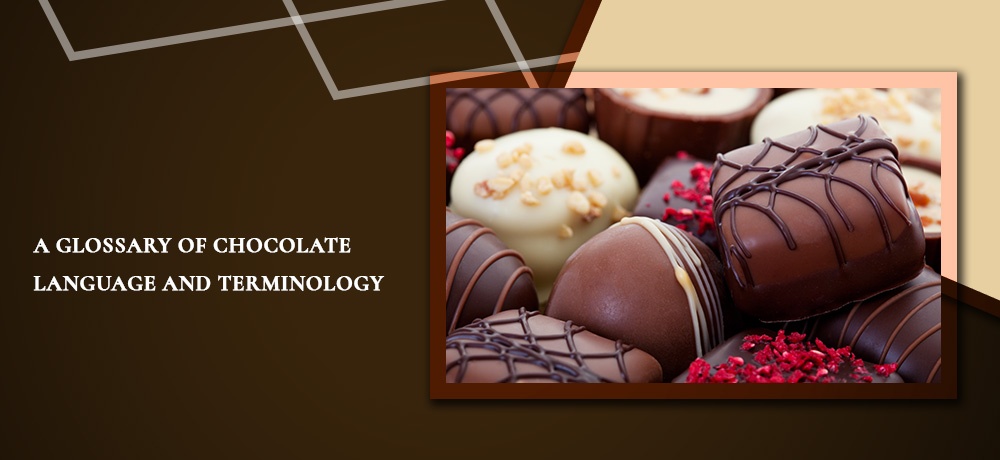A Glossary Of Chocolate Language And Terminology

Every industry has its language and terms. These words and phrases can be confusing to anyone who is not part of the daily operations of a specific sector, and the exciting world of chocolate is no different.
To help you understand the language and terms used by a chocolatier or give you an idea of the language used in a chocolate shop, A Cacao Affair has created this handy reference guide. Here you’ll find valuable information allowing you to comprehend and communicate your chocolate needs.
Tempering chocolate
This means melting chocolate to a specific temperature depending on the chocolate type (dark, milk, or white), dropping the temperature, and then bringing the temperature back up to the correct level. It is imperative to temper chocolate in order to get a shine, snap, and easy molding.
Ganache
A ganache is a mixture of heavy cream, fruit puree, glucose syrup (or other), and chocolate. It is a rich chocolate concoction that can be used as a sauce, frosting, glaze, filling, or for dipping.
Bonbon vs. truffle
A bonbon will be a molded truffle using polycarbonate or plastic mold with a shape.
A truffle will be piped or hand-rolled, then dipped in chocolate, nuts, cocoa powder, etc.
Chocolate bloom
When the cacao butter in chocolate separates from the other ingredients, floats to the top, and crystallizes, it appears as white dots and streaks or as a dull, gray film on the chocolate. This is only a cosmetic effect and does not mean the chocolate is spoiled. The cacao butter will blend in when the chocolate is melted. This condition is also called fat bloom.
Chocolate liquor
This bitter liquid or paste is produced when cacao beans are roasted and ground and is usually used as a baking ingredient. The chocolate liquor is cooled and molded into blocks (unsweetened baking chocolate). The liquor and blocks contain roughly 53% cacao butter.
Conching
A conching machine kneads the chocolate paste while maintaining controlled temperatures. This process develops flavors and changes the texture. It’s the last and most crucial refining process, which allows the distinct flavors of the individual ingredients to combine. Conches (the paddles of the early machines resembled conch shells) are equipped with heavy rollers that plow back and forth through the chocolate paste for anywhere from a few hours to several days. Contemporary technologies can grind the chocolate particles extremely fine, reducing conching times. Swiss and Belgian chocolates are conched as much as ninety-six hours. Some chocolates are not conched at all, or for only four to twelve hours.
Couverture
This is a term describing professional quality coating chocolate that is extremely glossy. It usually contains a minimum of 32% cocoa butter, which enables it to form a much thinner shell than ordinary confectionary coating. Couverture is usually only found in specialty candy-making shops. You often see it as the chocolate that surrounds chocolate-covered fruits or as the shell of fancy-filled chocolates.
Crystallization
Sugar crystals are formed during the process of cooking sugar when the particles stick together because the liquid they are mixed with is saturated to its fullest point and cannot absorb any more sugar. Whether fudge has a grainy or smooth texture is determined by controlling the sugar crystallization. If the mixture is stirred while warm, large crystals form and produce a grainy texture. Small crystals form if it is stirred when cool, resulting in a smooth consistency. Sugar crystallization also occurs when moisture accumulates on the surface of the chocolate and the sugar is drawn up. This condition is called sugar bloom, visible as white streaks and dots and a grainy texture. It is not the same as chocolate bloom.
Enrobe
This is the process of coating candies and confections with chocolate in a specially designed machine.
Cocoa nibs
Cocoa nibs are the inner almond-shaped seed of the cacao bean. The nibs are exposed after the outer shells of the cacao bean have been removed. Nibs are roasted, then ground to produce chocolate liquor, from which all chocolate products are made.
Non-alkalized cocoa powders
These are natural process powders, manufactured without the use of alkali, usually yellowish-brown color, fruity and acidy flavor. The best natural non-alkalized cocoa powder preserves the authentic flavor and complexity of the cocoa bean.
Semi-sweet or bittersweet
This is chocolate liquor with additional sweeteners and cacao butter. It is also known as dark chocolate. According to United States standards, it must contain at least 35% chocolate liquor. Its fat content averages 27%.
Snap
Snap is a technical term that describes one of the characteristics of well-tempered chocolate. It should break cleanly and crisply with a sharp snap and not be crumbly or soft.
Viscosity
This is a measure of the coating thickness of melted chocolate, which determines its ability to coat or enrobe confections. Melted chocolate has varying degrees of viscosity depending on its types (dark, milk, or white) and whether or not it is couverture, which contains a higher percentage of cocoa butter than regular chocolate.
Winnowing
Winnowing is the process of removing the outer husk of the cacao bean to release the inner nibs during the manufacturing of chocolate.
If you’re looking for custom-made and assorted chocolates in Marietta, reach out to the experts at A Cacao Affair. We combine artistry with scrumptious chocolate to create gourmet creations for your taste palate. No artificial flavors or sweeteners are used, and all ingredients are natural to produce the optimal flavor experience.
Get in touch with us today!
To learn more about the products we offer, please click here. To get in touch with us, please click here or call us at (678) 903-4534.